People
‘Joy Can Be an Act of Resistance’: Rising-Star Artist Tariku Shiferaw on the Provocatively Happy Ideas Behind His Abstractions
The artist's latest show includes paintings inspired by the sky.

The artist's latest show includes paintings inspired by the sky.

Katie White

Tariku Shiferaw believes joy can be radical.
For his new solo show at Galerie Lelong in New York, which opened this month (“It’s a Love Thang, It’s a Joy Thang“), Shiferaw has transformed the gallery into a metaphysical oasis of sorts.
His dazzling blue canvases, crossed by rectangular bars of blacks and browns, appear like glimpses of ocean and sky. Shipping pallets painted black hang on the walls at oddly musical and surprisingly uplifting angles. There’s a palm tree, a bit of sand. A sense of personal refuge, of rest, fills up the show.
Everything here is purposeful. The Addis Ababa-born, Los Angeles-raised artist takes utilitarian materials—transparent mylar, shipping pallets, a chainlink fence—and enters them into the formal language of abstraction. The materials hint at an industrial, urban existence, and the horizontal bars of his paintings and the pallets can be read as prison bars.
Meanwhile, the interplay of blacks and blues in his works evoke visions both brutal and beautiful: bruised skin, blues music, the police and the Black bodies, the sky in the day and the sky at night.
In these works, all made over this past year of unrest and worldwide suffering, these contradictory elements of joy and pain are entwined. Refuge can only exist in contrast.
We caught up with Shiferaw at his residency at Silver Art Projects at the World Trade Center and talked to him about everything from a pivotal experience that changed the way he saw the sky, to the poem he can’t stop thinking about.
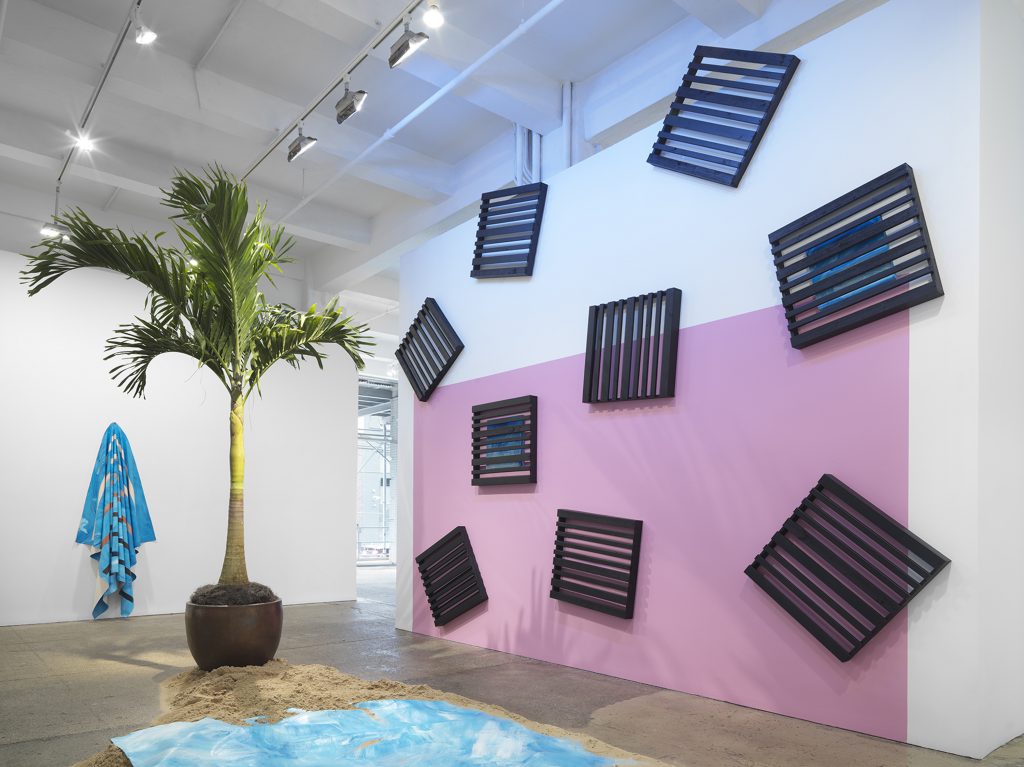
Tariku Shiferaw, Jerusalema (Master KG) (2021). Courtesy of Galerie Lelong.
Can you talk about how you conceptualized the gallery space for the exhibition? The installation Jerusalema (Master KG) is site-specific and creates a kind of oasis within the gallery.
There is a smaller room at the front that contrasts with the larger, main gallery space. I started messing around in [computer-modeling program] SketchUp and coming up with ideas to engage the space. In an earlier installation at Beverly’s, I included a mirror, and on the other wall, a blue backdrop. So when you look at it, you see yourself surrounded by blue in this “Oh shit!” moment.
So I knew I wanted to include a reflective surface, which you see in Jerusalema (Master KG). We also brought a palm tree into the gallery. Palm trees have become, in our society, a way to demarcate a vacation place, but growing up in Los Angeles they were on every block. In that sense, it’s like bringing a little piece of home with me. I wanted to capture this idea of letting your hair down. Then there’s a little bit of sand. I just wanted to make a place where you could have a moment, have a little bit of your own space. I was thinking about creating that for myself, but also thinking of those that have come before us. Joy can be an act of resistance.
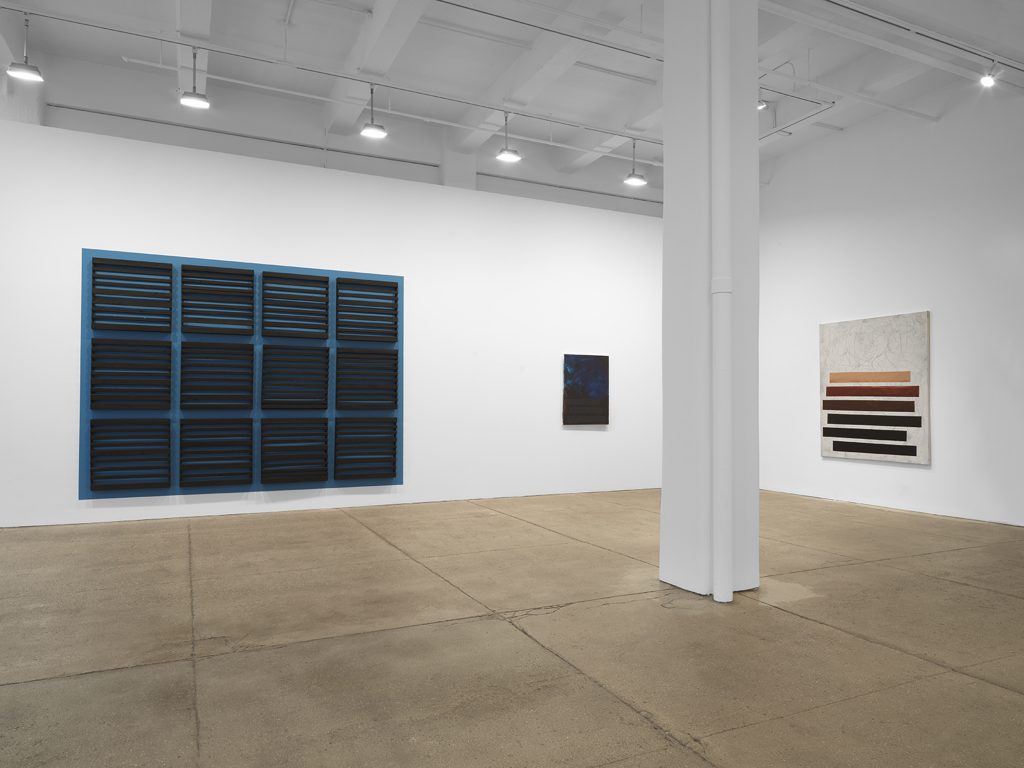
Installation view “It’s a Love Thang, It’s a Joy Thang” 2021. Courtesy of Galerie Lelong.
Tell me more about what you mean by that.
I had in mind Toi Derricotte’s poems about her fish, Telly, “The Telly Cycle,” and her line “Joy is an act of resistance.” She writes about how much joy this little fish brought her, and how she tried to care for him. Many of her friends criticized her for spending hundreds of dollars on Telly, paying for medicine and for people to come feed him, saying you could just purchase another fish like that for $1.98. But that fish brought her joy.
I was interested in how people assign value to another life, and the belief that Telly doesn’t deserve to live as much as the rest of us. I was thinking about bodies, Black bodies, and the way we exist in society, and how joy has the power to disrupt. So all these thoughts are at play in the exhibition. Ultimately though, I just want to take it back to a moment of blue sky.
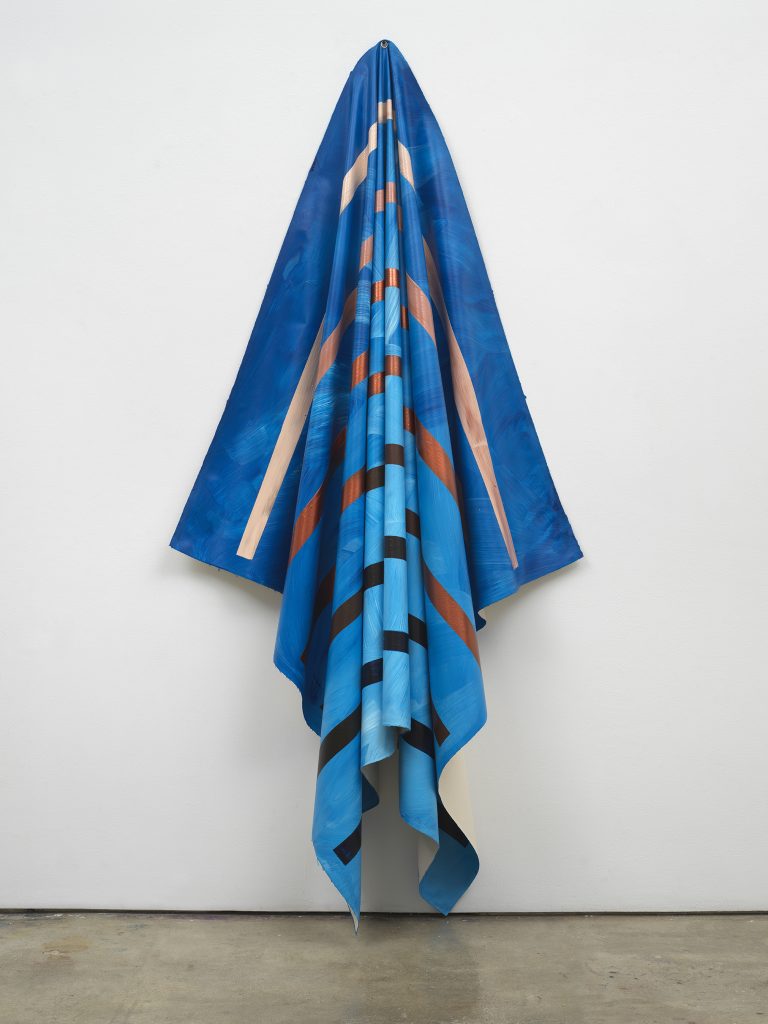
Tariku Shiferaw, High Fashion (Roddy Ricch) (2021). Courtesy of Galerie Lelong.
Why is the sky such a fascination?
I had a very inspiring, pivotal moment. In 2013, I encountered this life-size mirror that was thrown on the sidewalk of my street in Los Angeles. It was a dirt sidewalk where the grass had not grown yet. The mirror was cracked and it had just rained. Over the weeks, bits of grass started growing through the shards of the mirror. You could see the blue sky and the clouds and then the trees on its surface. I laid down in this glass and there was all around me this floating sky, but then the green of the grass. That image stayed in my imagination.
Then I moved to New York from LA and a little bit later, they had a show of Rene Magritte at MoMA and there was a kind of carpet on one part of the floor covered with his clouds. It was like walking on air. Magritte is one of my favorite artists and this entered my head as something I could do: enter the sky.
So if you look at these paintings, the blues of the works with pallets have the color of sky or water, leading into Loverboy (Billy Ocean), this huge constellation painting that is a kind of night sky. The idea of the sky I’m working on within the exhibition is one in which you can leave the here and now to go into another place where you can find your “joy thang.”
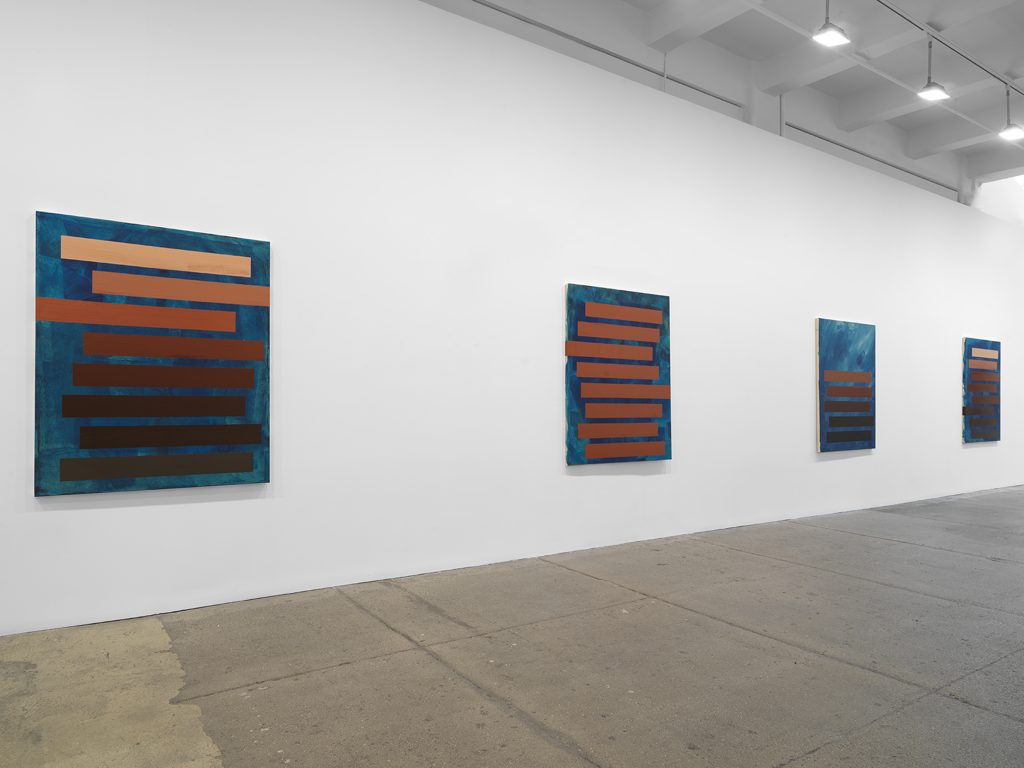
Installation view “It’s a Love Thang, It’s a Joy Thang” 2021. Courtesy of Galerie Lelong.
Your paintings often include staggered horizontal bands that have been likened to censorship bars or the bars of a prison cell. They also speak to your interest in mark-making as an invocation of the self. What drew you to that shape?
First of all, these shapes are aesthetically pleasing for me to engage with. But they were also inspired by the stacked-up shipping pallets that I’ve encountered throughout my life in Los Angeles and especially after moving to New York. I always found them very cool—they’re all wood but some are dirty or smeared, and others a blue. Some were bleached by the sun. When I think of them I hear the “beep, beep, beep” of a truck backing up in my head. Subconsciously, the bands entered my sketchbook three years before I ever started making them in my paintings. Then one day it just clicked as I was simultaneously thinking about how to mark myself into history and society.
I had all these blue backgrounds and I would make these black gestures until it felt right. I was thinking about these cave markings in different parts of the world, in Australia or Indonesia, that have endured for 40,000 years. These people left a mark on their society for us today to find and say, “Oh, they did exist.” Which is something I wanted to join into in our own society.
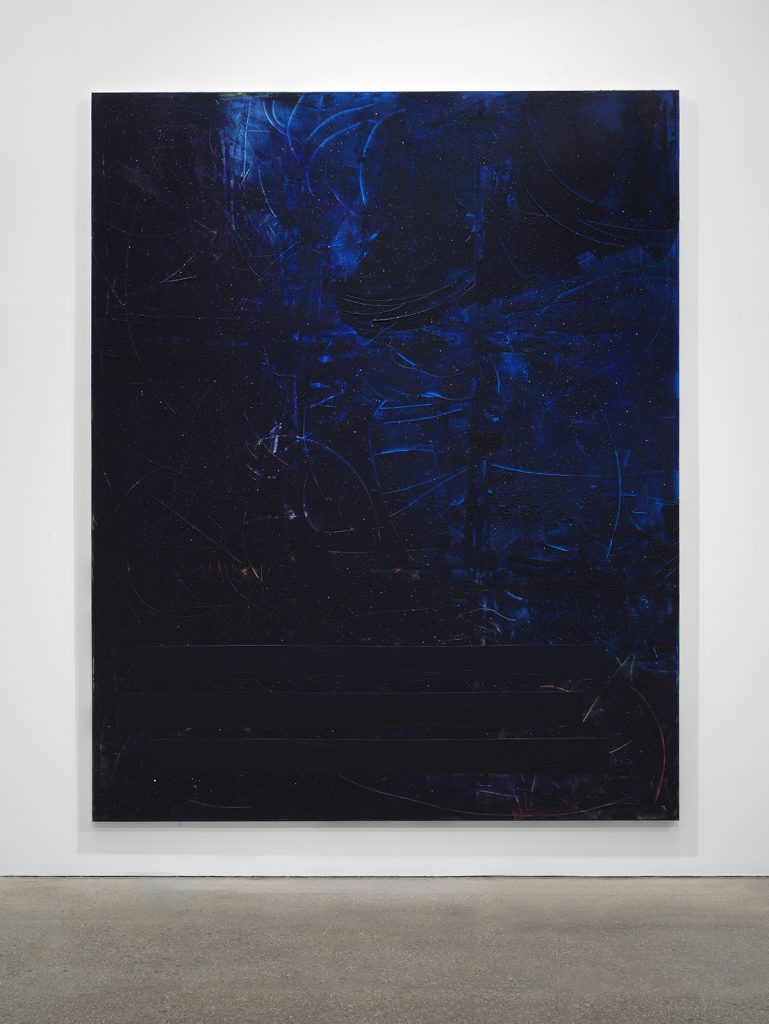
Tariku Shiferaw, Loverboy (Billy Ocean) (2021). Courtesy of Galerie Lelong.
All of your works in the exhibition are named after songs by Black musicians. What is the role of music in your work? Why these names?
Just the markings were not enough in terms of painting. Geometric abstraction engages formalism in a way that didn’t touch on the societal sense of these marks. Instead of leaving them untitled, I start titling them after songs by musicians from the Black diaspora—pop, R&B, jazz, blues, reggae. These names give them a reference to the outside world.
The titles draw back to the Black body and Black culture. Shipping pallets are an international symbol of commodity and trade, and then we touch on the history of how Black bodies and Black culture had been treated as a commodity brought from Africa around the world. In music, there has always been a space, a little window for imagining a kind of escape. One of the works is named for Kendrick Lamar’s song King Kunta, where he imagines himself as the character from Alex Haley’s 1976 novel Roots. These songs are filled with radical ideas of a world of the future. As with the title, “It’s a Love Thang, It’s a Joy Thang,” I was thinking about that type of escape and music, like the sky, is a space for imaging an alternative reality.
I know you’re something of an art history buff. Does that influence your work? And are there any artists that you particularly admire?
I like the freedom I have with painting where I’m not really bound to the history of it. It feels like taking a little bit of control back in the conversation—if you’re engaging art history, you’re thinking you stay within these parameters so painters develop a certain style. Conceptually, I have been really interested in John Baldessari, the way he thinks about paintings, taking it out of that context of art-historical limitation. Duchamp and Warhol also engaged art in a similar way. Barnett Newman’s writings—well, it can be a little obnoxious—but it’s still interesting to me. Also, Agnes Martin, Jack Whitten, Ed Clark.
Most directly, as artists a generation, above me, I think Julie Mehretu and Laura Owens have had a lot of influence on me, and the way Julie Mehretu creates cosmologies that are both in and outside of our moment especially.
What does abstraction afford you that figuration does not?
You don’t have a marked door to enter through in abstraction. You sort of have to find your own door to get in. You have to wait and then if you’re patient things can unfold in very interesting ways.